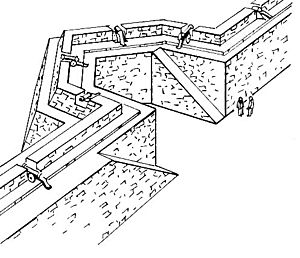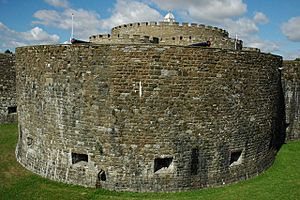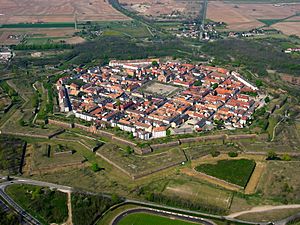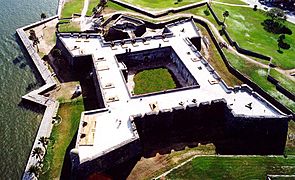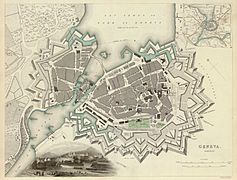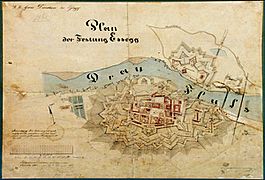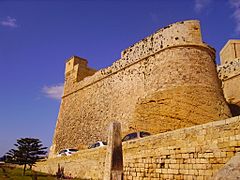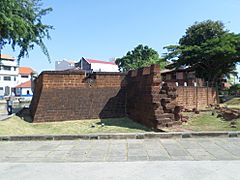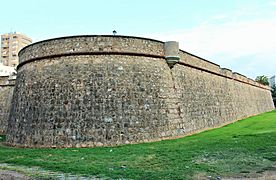Bastion facts for kids
A bastion (say: BASS-chun) is a strong part of a fortification or fort. It sticks out from the main wall, often at the corners. Bastions usually have two main sides and two shorter sides. These shorter sides help protect the main wall and other bastions with gunfire.
Bastions were much better than older medieval towers. They offered stronger defense against cannons and other powerful weapons. Bastions were a key part of military building from the mid-1500s to the mid-1800s.
Contents
How Bastions Developed
By the mid-1400s, cannons became very strong. They could easily destroy the round towers and walls of medieval castles. For example, during the Hundred Years War, French armies used cannons to capture English towns and castles. Also, in 1453, the city of Constantinople fell to a Turkish army using huge cannons. This showed that new fort designs were needed.
During the Eighty Years War (1568–1648), Dutch engineers improved bastions. They made the front parts longer and the main walls shorter. They called these new structures bolwerk. To make them even stronger, they added V-shaped outer walls called ravelins. These ravelins were placed in front of the bastions and main walls. They helped protect them from direct cannon fire.
Later, a famous French engineer named Sébastien Le Prestre de Vauban further developed these ideas. He created the "trace italienne" style of forts. These strong forts were used even during the Napoleonic Wars.
Why Bastions Were Effective
Bastions were different from older medieval towers in several ways:
- Bastions were lower than towers. This made them harder for enemy cannons to hit and destroy.
- They usually had a deep ditch in front. The ground on the other side of the ditch sloped away gently. This sloped ground, called a glacis, hid most of the bastion from enemy cannons.
- Unlike curved medieval towers, most bastions had flat sides. This meant defenders could shoot at any spot directly in front of the bastion. There were no "dead zones" where attackers could hide.
- Bastions were also much larger than most towers. This allowed more cannons to be placed on them. It also gave enough space for the soldiers to operate the cannons safely.

The outer walls of bastions were often made of stone. But this stone was just a covering. Behind it was a thick layer of packed earth or rubble. This soft material absorbed cannonballs, stopping them from breaking through. The very top of the bastion was usually left without stone. If cannonballs hit stone here, dangerous stone shards could fly around and hurt the defenders.
If attackers managed to storm a bastion, it could become a problem. They could use it as a base to attack the rest of the fort. Some bastion designs tried to prevent this. They used "retrenchments," which were trenches dug across the back of the bastion. This would cut off the bastion from the main fort, making it harder for attackers to use it.
Different Kinds of Bastions
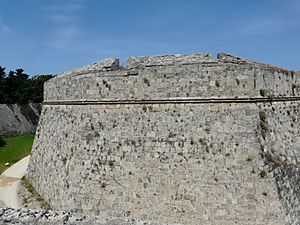
Over time, different types of bastions were built:
- Solid bastions were completely filled with earth. Their top surface was level with the main wall.
- Void or hollow bastions had walls only around their edges. This left an empty space in the middle. If the outer wall was captured, it was hard to build new defenses inside.
- A flat bastion was built in the middle of a long main wall. This was done when the wall was too long to be defended by bastions at its ends.
- A cut bastion had a sharp, inward-pointing angle at its tip. This was used when the normal corner would be too narrow.
- A demi-bastion had only one main side and one shorter side. These were often used to fortify sharp corners or in front of other defenses like hornworks.
Gallery
-
Castillo de San Marcos (completed 1695), Florida. A fort with four bastions.
-
One of the bastions of the castle of Copertino (1540), Italy.
-
Plan of Geneva in 1841. Its huge fortifications, with many bastions, were taken down ten years later.
-
St. Martin's Demi-Bastion in the Cittadella (1614), Gozo, Malta.
-
Bastion in Badajoz Spain.
See also
 In Spanish: Baluarte para niños
In Spanish: Baluarte para niños
- Bastille
- Battery tower
- Roundel
- Bastion host


